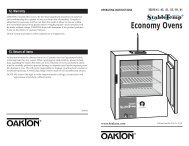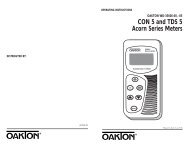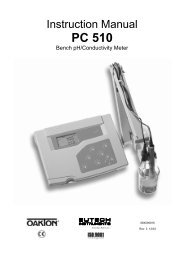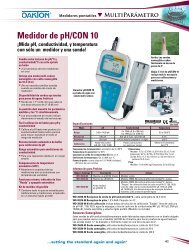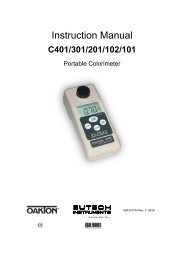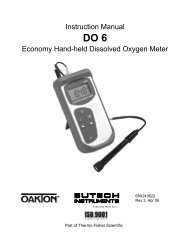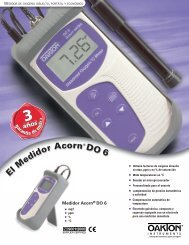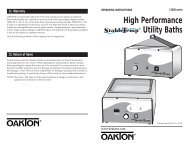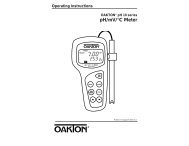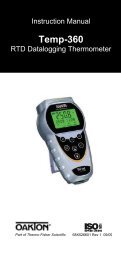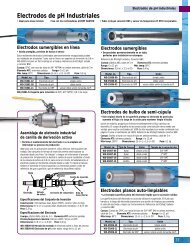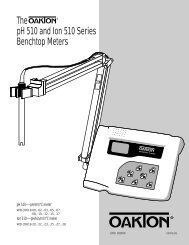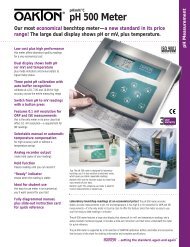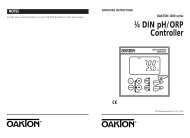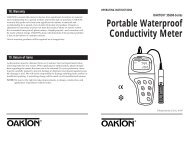EC/TDS/SALT Testr - ACT Waterwatch
EC/TDS/SALT Testr - ACT Waterwatch
EC/TDS/SALT Testr - ACT Waterwatch
You also want an ePaper? Increase the reach of your titles
YUMPU automatically turns print PDFs into web optimized ePapers that Google loves.
This Instruction Manual is also available for download on our Web-site: eutechinst.com or 4oakton.com<br />
INSTRUCTION MANUAL<br />
<strong>EC</strong>/<strong>TDS</strong>/<strong>SALT</strong> <strong>Testr</strong><br />
Large Screen<br />
Waterproof Conductivity/<strong>TDS</strong>/Salt Tester<br />
Introduction<br />
Thank you for selecting our microprocessor-based waterproof <strong>EC</strong> / <strong>TDS</strong> / <strong>SALT</strong> tester with large<br />
dual line display. You have one of the following models:<br />
• <strong>EC</strong><strong>Testr</strong>low • <strong>EC</strong><strong>Testr</strong>low+ • <strong>EC</strong><strong>Testr</strong>high • <strong>EC</strong><strong>Testr</strong>high+ • <strong>EC</strong><strong>Testr</strong>pure+<br />
• <strong>TDS</strong><strong>Testr</strong>low • <strong>TDS</strong><strong>Testr</strong>low+ • <strong>TDS</strong><strong>Testr</strong>high • <strong>TDS</strong><strong>Testr</strong>high+ • <strong>TDS</strong><strong>Testr</strong>pure+<br />
• <strong>SALT</strong><strong>Testr</strong><br />
The non plus models are designed with user-replaceable two-pin type sensor with many user friendly<br />
features such as the Hold function, Automatic Temperature Compensation and Self-Diagnostic Messaging<br />
capabilities. The plus models, with the user-replaceable cup type sensor, have more additional<br />
features such as simultaneous temperature display, °C or °F selection, and have higher resolution<br />
measurement.<br />
This manual provides a step-by-step guide to operate the testers.<br />
Before you begin:<br />
Remove the electrode’s protective cap. Soak the electrode for a few minutes in alcohol to remove any<br />
oil stains on the electrodes which will affect the accuracy of the tester. Rinse thoroughly with deionized<br />
water and shake off dry.<br />
Calibration<br />
The tester is factory calibrated. However, to ensure accuracy, you can calibrate the tester on a regular<br />
basis. Depending on the model selected, you can calibrate the Conductivity / <strong>TDS</strong> / Salt / Temperature<br />
on a one point calibration using the appropriate calibration standard.<br />
The following table lists each model allowable calibration range when selecting a calibration standard.<br />
It is best to select a standard close to the test solution value.<br />
1. Organise your calibration standard solution in two beakers – one for rinsing and<br />
the other for calibration. Prepare separate de-ionized water for electrode rinsing.<br />
2. Twist off and open the battery compartment lid (the cap with the lanyard loop).<br />
You will see two switches – the INC (increment) and D<strong>EC</strong> (decrement) keys.<br />
3. Switch on the unit using the ON/OFF key.<br />
4. Rinse the electrode in de-ionized water and then rinse with the calibration INC Key<br />
standard.<br />
+<br />
5. Dip the electrode to the calibration standard intended for calibration<br />
and swirl gently to create a homogenous sample. Wait for the reading<br />
to stabilize.<br />
-<br />
6. Press the INC or D<strong>EC</strong> key to enter calibration mode and to adjust the<br />
reading to the calibration standard value. The upper display will be the<br />
adjustable reading for calibration whereas the lower display will be the<br />
default reading of the standard.<br />
Note: At this point, the non-plus models will have its upper and lower display showing readings<br />
with resolution of its plus version. Reading adjustment can then be made from its last significant<br />
digit. Upon confirming the calibration, the reading changes back to its original resolution.<br />
7. Wait for 5 seconds for the tester to automatically confirm the calibration value by displaying<br />
“CO” and return to the measurement mode.<br />
8. Replace the battery compartment lid. The tester is now ready for measurement.<br />
Note: To exit this program without confirming the calibration, press the HOLD button before the<br />
automatic confirmation takes place.<br />
Note: The tester will exit calibration mode with “Er.0” message if the temperature is outside the<br />
0 to 50°C range. Please refer to information under ’Self Diagnostic Messages’.<br />
Note: The calibration window is +/- 50% from the default reading of the standard.<br />
Figure 1: Example of a calibration sequence using 2764 µS calibration standard<br />
Measurement<br />
INC<br />
D<strong>EC</strong><br />
INC<br />
D<strong>EC</strong><br />
After 5 sec,<br />
“CO” is<br />
displayed<br />
signifying<br />
automatic<br />
confirmation<br />
1. Press the ON/OFF button to switch the tester on.<br />
2. Dip the electrode into the test solution making sure that it is fully immersed. Stir to clear any<br />
trapped air bubbles from the electrode and let the reading stabilize. For plus models, you<br />
can opt for the cup style measurement by filling the electrode cup with sample of test solution.<br />
3. Note the value or press HOLD button to freeze the reading. To release the reading, press HOLD<br />
again.<br />
4. Press ON/OFF to turn off tester. If you do not press a button for 8.5 minutes, the tester will<br />
automatically shut off to conserve batteries.<br />
HOLD Function<br />
This feature lets you freeze the display for a delayed observation.<br />
1. Press HOLD button to freeze the measurement. A ‘HOLD’ indicator will be displayed and the<br />
measurement will be frozen.<br />
2. Press HOLD again to release the measurement. The ‘HOLD’ indicator will not be displayed<br />
anymore indicating the held measurement is released.<br />
Figure 3: Example of HOLD Function<br />
Temperature Mode Selection (Only for PLUS Models)<br />
This feature lets you select either the Celsius (°C) or the Fahrenheit (°F) temperature mode<br />
display.<br />
From the measurement mode,<br />
1. Press °C/°F button to select the desired temperature mode. The temperature<br />
display will toggle between the Celsius reading and the Fahrenheit reading.<br />
Figure 4: Example of a temperature mode selection<br />
<strong>TDS</strong> Factor Setting (Only for <strong>TDS</strong> Models)<br />
The <strong>TDS</strong> models features includes the setting of the <strong>TDS</strong> factor. You can adjust the <strong>TDS</strong> factor from 0.4<br />
to 1.0.<br />
From the measurement mode,<br />
1. Press HOLD button to bring the tester to the HOLD mode.<br />
2. Press either the INC or D<strong>EC</strong> key to enter the <strong>TDS</strong> Factor Setting mode. The upper display will<br />
be the adjustable <strong>TDS</strong> factor whereas the lower display will be the last <strong>TDS</strong> Factor setting.<br />
3. Use the INC or D<strong>EC</strong> key to set the correct <strong>TDS</strong> factor for your sample measurement.<br />
4. Wait for 5 seconds for the tester to automatically confirm the new setting by displaying “CO”<br />
and return to the measurement mode.<br />
INC<br />
D<strong>EC</strong><br />
INC<br />
D<strong>EC</strong><br />
After 5 sec,<br />
“CO” is<br />
displayed<br />
signifying<br />
automatic<br />
confirmation<br />
Model<br />
<strong>EC</strong><strong>Testr</strong><br />
estrlo<br />
low<br />
<strong>EC</strong><strong>Testr</strong><br />
estrlo<br />
low+<br />
<strong>EC</strong><strong>Testr</strong>high<br />
<strong>EC</strong><strong>Testr</strong>high+<br />
<strong>EC</strong><strong>Testr</strong><br />
estrpur<br />
pure+<br />
Calibration 200 to 1990 200 to 1999 2.00 to 19.90 2.00 to 19.99 20.0 to 199.9<br />
Standard Range uS/cm uS/cm mS/cm mS/cm uS/cm<br />
Model<br />
<strong>TDS</strong><strong>Testr</strong><br />
estrlo<br />
low<br />
<strong>TDS</strong><strong>Testr</strong><br />
estrlo<br />
low+<br />
<strong>TDS</strong><strong>Testr</strong>high<br />
<strong>TDS</strong><strong>Testr</strong>high+<br />
<strong>TDS</strong><strong>Testr</strong><br />
estrpur<br />
pure+<br />
<strong>SALT</strong>estr<br />
Calibration 200 to 200 to 1.00 to 1.00 to 20.0 to 1.00 to<br />
Standard Range 1990 ppm 1999 ppm 10.00 ppt 10.00 ppt 199.9 ppm 10.00 ppt<br />
Table 1<br />
ON/OFF<br />
Figure 2: Example of a Power Up Sequence<br />
Electrode Maintenance<br />
Figure 5: Example of setting the <strong>TDS</strong> Factor<br />
1. Always keep the sensor electrodes clean. Rinse the electrodes with de-ionized water and<br />
wipe them dry with clean cloth before storing with its protective cap. For the plus models,<br />
remove the white plastic cup insert to thoroughly clean viscous solutions. Never scratch<br />
the electrodes with a hard substance.<br />
2. For better performance, soak the electrode in alcohol for 10 to 15 minutes and rinse with<br />
de-ionized water before starting any measurement process. This is to remove dirt and oil<br />
stains on the electrode which may affect the accuracy of the measurements.
Temperature Calibration (Only for PLUS Models)<br />
Temperature calibration need not be performed every time, unless the temperature reading differs<br />
from that of an accurate thermometer. If temperature calibration is performed, Conductivity/<strong>TDS</strong>/Salt<br />
calibration is mandatory.<br />
From the measurement mode,<br />
1. Press the °C/°F button to select the desired temperature mode (Celsius or Fahrenheit).<br />
2. Dip the tester into a solution of known temperature and allow time for the in built temperature<br />
sensor to stabilize.<br />
3. Press either the INC or D<strong>EC</strong> key to bring the tester to the calibration mode.<br />
Note: At this stage, if the Conductivity/<strong>TDS</strong>/Salt reading is outside the specified range (showing Or<br />
or Ur), the tester will show an error message of “Er.1”. You can still proceed with the temperature<br />
calibration by continuing with step 4 or if the °C/°F button is not pressed within 2 seconds, the tester<br />
will exit the calibration mode and return to the measurement mode.<br />
4. Immediately press the °C/°F button to switch to the temperature calibration mode. The upper<br />
display shows the current measured temperature reading based on the last set offset and the<br />
lower display shows the current measured temperature reading based on factory default calibration.<br />
5. Use the INC and D<strong>EC</strong> key to adjust the upper temperature reading to the known temperature value.<br />
6. Wait for 5 seconds for the tester to automatically confirm the temperature calibration value by<br />
displaying “CO” and return to the measurement mode.<br />
Note: To exit this program without confirming the calibration, press the °C/°F button or the HOLD<br />
button before the automatic confirmation takes place.<br />
Note: The tester will exit calibration mode with “Er.0” message if the temperature is outside the 0 to<br />
50°C range. Please refer to information under ’Self Diagnostic Messages’.<br />
Notes: The temperature calibration window is +/- 5°C (+/- 9°F) from the default temperature reading.<br />
INC<br />
D<strong>EC</strong><br />
Figure 6: Example of a temperature calibration sequence<br />
Changing Batteries<br />
1. Open the battery compartment lid (with attached lanyard loop).<br />
2. Remove old batteries; replace with fresh ones. Note polarity<br />
(shown in diagram below).<br />
INC Key<br />
Electrode Replacement<br />
You can replace the electrode module at the fraction of the cost of a new tester. When the tester fails<br />
to calibrate or gives fluctuating readings in calibration standards, you need to change the electrode.<br />
1. With dry hands, grip the ribbed tester collar with electrode facing you. Twist the collar counter<br />
clockwise (see picture A). Save the ribbed tester collar and O-ring for later use.<br />
2. Pull the old electrode module away from the tester.<br />
3. Align the four tabs on the new module so that they match the four slots on the tester (see<br />
picture B).<br />
4. Gently push the module onto the slots to sit it in position. Push the smaller O-ring fully onto<br />
the new electrode module. Push the collar over the module and thread it into place by firmly<br />
twisting clockwise.<br />
Note: It is necessary that you recalibrate your tester prior to measurement after an electrode<br />
replacement.<br />
INC<br />
D<strong>EC</strong><br />
After 5 sec,<br />
“CO” is<br />
displayed<br />
signifying<br />
automatic<br />
confirmation<br />
+<br />
-<br />
Self-Diagnostic Messages<br />
Low battery<br />
indicator<br />
Over range /<br />
Under range<br />
signal<br />
Error<br />
Message<br />
Or / Ur<br />
(Still)<br />
Figure 7: Removal of collar from tester<br />
ATC / Or /<br />
Ur (Blinking)<br />
Er.0<br />
.0<br />
Er.1<br />
.1<br />
3 Bars indicates Battery is full (100%)<br />
2 Bars indicates 50% of the battery life is left<br />
1 Bar indicates 25% of the battery life is left<br />
Blinking battery casing indicates the need to replace<br />
batteries with fresh ones as specified by manufacturer<br />
The sensor electrodes have short circuited.<br />
Replacement sensor is not connected properly to the<br />
tester during sensor replacement<br />
Measured value or temperature value (for plus models)<br />
exceeds its specified maximum or minimum value<br />
Blinking ‘ATC’, ‘Or’ or ‘Ur’ indicates that there is a short<br />
or open circuit at the built in temperature sensor<br />
Calibration error due to temperature value not within the<br />
specified range<br />
Calibration error due to Conductivity/<strong>TDS</strong>/Salt value not<br />
within the specified calibration standard range<br />
Applications<br />
Water quality testing • pools • aquaculture • hydroponics • ecology studies • water and<br />
wastewater treatment • boilers • labs and more!<br />
Accessories<br />
Item<br />
Roate collar<br />
away from you<br />
Ribbed collar<br />
Insert Electrode Module<br />
Electrode Module<br />
Large O-Ring<br />
Small O-Ring Small Tab Large Tab<br />
Eutech Instruments Order Code Oakton Instruments Order Code<br />
<strong>EC</strong>TESTR, <strong>TDS</strong>TESTR & <strong>SALT</strong>ESTR <strong>EC</strong><strong>TDS</strong>WPSENNEW OK<strong>TDS</strong>WPSENNEW<br />
replacement sensor<br />
<strong>EC</strong>TESTR+ & <strong>TDS</strong>TESTR+ <strong>EC</strong><strong>TDS</strong>WPSENPLUS OK<strong>TDS</strong>WPSENPLUS<br />
replacement sensor<br />
Warranty<br />
These waterproof Conductivity/<strong>TDS</strong>/Salt tester series - <strong>EC</strong><strong>Testr</strong>, <strong>TDS</strong><strong>Testr</strong> and <strong>SALT</strong><strong>Testr</strong> are<br />
warranted to be free from manufacturing defects for 2 years and electrode module for 6 months.<br />
If repair, adjustment or replacement is necessary and has not been the result of abuse or misuse<br />
within the time period, please return the tester – freight prepaid – and correction will be made<br />
without charge. Out of warranty products will be repaired on a charge basis.<br />
Return of Items<br />
Authorization must be obtained from your distributor before returning items for any reason.<br />
When applying for authorization, please include information regarding the reason the item(s) are<br />
to be returned.<br />
Note: We reserve the right to make improvements in design, construction and appearance of<br />
products without notice. Prices are subject to change without notice.<br />
<strong>EC</strong><strong>Testr</strong> Specifications<br />
Large Screen <strong>EC</strong><strong>Testr</strong>low<br />
<strong>EC</strong><strong>Testr</strong>low+<br />
<strong>EC</strong><strong>Testr</strong>high<br />
<strong>EC</strong><strong>Testr</strong>high+<br />
<strong>EC</strong><strong>Testr</strong>pure+<br />
<strong>EC</strong><br />
Tester<br />
Range 0 to 1990 uS/cm 0 to 1999 uS/cm 0 to 19.90 mS/cm 0 to 19.99 mS/cm 0 to 199.9 uS/cm<br />
Resolution 10 uS/cm 1 uS/cm 0.10 mS/cm 0.01 mS/cm 0.1 uS/cm<br />
Accuracy<br />
+/- 1% FS<br />
Calibration point<br />
1 point (± 50% window from factory default)<br />
Calibration 200 to 1990 200 to 1999 2.00 to 19.90 2.00 to 19.99 20.0 to 199.9<br />
Standard Range uS/cm uS/cm mS/cm mS/cm uS/cm<br />
Temperature<br />
Yes<br />
Yes<br />
Range in °C 0.0 to 50.0°C 0.0 to 50.0°C<br />
Range in °F 32.0 to 122°F 32.0 to 122°F<br />
Resolution NA<br />
0.1°C (0.1°F) NA<br />
0.1°C (0.1°F)<br />
Accuracy ±0.5°C (±0.9°F) ±0.5°C (±0.9°F)<br />
Calibration point 1 point 1 point<br />
Calibration Window ± 5°C (± 9°F) ± 5°C (± 9°F)<br />
from factory default from factory default<br />
ATC 0 to 50°C<br />
Temp Coefficient 2% per °C<br />
Normalization Temp<br />
25.0°C<br />
Auto Off<br />
8.5 minutes after last key press<br />
Operating Temp 0 to 50°C<br />
Power Battery<br />
4 X 1.5V”A76" micro alkaline battery<br />
Battery Life<br />
>150 hrs<br />
LCD Display<br />
Custom Dual Display27mm(H)X21mm(W)<br />
Dimensions<br />
Tester: 16.5 cm X 3.8 cm; 90g<br />
Weight<br />
Boxed: 22cm X 6cmX 5cm; 170 g<br />
<strong>TDS</strong><strong>Testr</strong> Specifications<br />
Large Screen <strong>TDS</strong><strong>Testr</strong>low<br />
<strong>TDS</strong><strong>Testr</strong>low+<br />
<strong>TDS</strong><strong>Testr</strong>high<br />
<strong>TDS</strong><strong>Testr</strong>high+<br />
<strong>TDS</strong><strong>Testr</strong>pure+<br />
<strong>TDS</strong><br />
Tester<br />
Range 0 to 1990 ppm 0 to 1999 ppm 0 to 10.00 ppt 0 to 10.00 ppt 0 to 199.9 ppm<br />
Resolution 10 ppm 1 ppm 0.10 ppt 0.01 ppt 0.1ppm<br />
Accuracy<br />
+/- 1% FS<br />
<strong>TDS</strong> Factor 0.4 to 1.0<br />
Calibration point<br />
1 point (± 50% window from factory default)<br />
Calibration 200 to 1990 200 to 1999 1.00 to 10.00 ppt 20.0 to 199.9<br />
Standard Range ppm ppm ppm<br />
Temperature NA Yes NA Yes<br />
Range in °C 0.0 to 50.0 °C 0.0 to 50.0 °C<br />
Range in °F 32.0 to 122 °F 32.0 to 122 °F<br />
Resolution 0.1 °C (0.1°F) 0.1 °C (0.1°F)<br />
Accuracy ±0.5 °C (±0.9 °F) ±0.5 °C (±0.9 °F)<br />
Calibration point 1 point 1 point<br />
Calibration Window ± 5°C (± 9°F) ± 5°C (± 9°F)<br />
from factory default<br />
from factory default<br />
ATC 0 to 50°C<br />
Temp Coefficient 2% per °C<br />
Normalization Temp<br />
25.0°C<br />
Operating Temp 0 to 50°C<br />
Power Battery<br />
4 X 1.5V”A76" micro alkaline battery<br />
Battery Life<br />
>150 hrs<br />
LCD Display<br />
Custom Dual Display27mm(H)X21mm(W)<br />
Dimensions<br />
Tester: 16.5 cm X 3.8 cm; 90g<br />
Weight<br />
Boxed: 22cm X 6cmX 5cm; 170 g<br />
<strong>SALT</strong><strong>Testr</strong> Specifications<br />
Large Screen <strong>TDS</strong> Tester<br />
<strong>SALT</strong>TESTR<br />
Range<br />
0 to 10.00 ppt<br />
Resolution<br />
0.10 ppt<br />
Accuracy<br />
+/- 1% FS<br />
Calibration point<br />
1 point (± 50% window from factory default)<br />
Calibration Standard Range<br />
1.00 to 10.00 ppt<br />
ATC 0 to 50°C<br />
Temperature Coefficient 2% per °C<br />
Normalization Temperature<br />
25.0°C<br />
Operating Temperature 0 to 50°C<br />
Power Battery<br />
4 X 1.5V”A76" micro alkaline battery<br />
Battery Life<br />
>150 hrs<br />
LCD Display<br />
Custom Dual Display27mm(H)X21mm(W)<br />
Dimensions<br />
Tester: 16.5cm X 3.8cm; 90g<br />
Weight<br />
Boxed: 22cm X 6cm X 5cm; 170g<br />
68X068050 09 / 04 Rev 0



